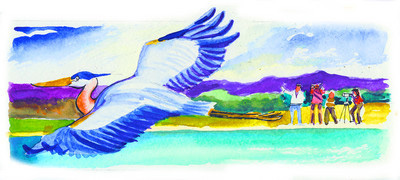Watching wildlife in Arizona made easy with group’s efforts
Spotting wildlife remains one of the joys of traveling America's roads and highways. Of course careful drivers scan the roadsides to avoid disasters of making roadkill of wild things, while youngsters in the vehicle make a game of listing species seen. They note the surprising variety of creatures of the woods, meadows, desert, mountains and waterways of our diverse landscapes, perhaps the only opportunities they have to see such creatures outside of city zoos.
Although many states actively promote their watchable wildlife, Arizona seems to be ahead of other states in efforts to attract tourists interested in seeing animals in the wild, not just for the purpose of hunting them. Similar efforts in Africa and elsewhere created a lucrative safari industry for photographers and interested travelers. Arizona involves businesses, wildlife organizations, state and national parks, tribal entities, and wildlife and land management agencies at all levels in this area of growing tourist appeal.
Nevadans traveling in Arizona benefit from the information available on the state's wild denizens and from events and programs designed to acquaint visitors with Arizona's creatures. The Arizona Watchable Wildlife Tourism Association coordinates much of the available information. To find out more about watchable wildlife in Arizona, contact this group at (602) 542-4174. The organization's Web site at www.azwatchablewildlife.org includes links to cooperating businesses, groups and agencies.
The association divides Arizona into regions with similar habitats. The Northern Arizona designation includes the Flagstaff area and the vast Kaibab Plateau on both rims of the Grand Canyon. North Central Arizona takes in the canyon country around Sedona and the Verde River Valley east to the high country around the White Mountains. Central Arizona includes the Phoenix area, wetlands and riparian areas along rivers. In Southern Arizona, visitors see portions of the Sonoran Desert around Tucson, canyons and mountain ranges to the Mexican border. Dubbed Arizona's West Coast, the Lower Colorado from Davis Dam south to Mexico boasts desert, mountains, canyons and wildlife refuges.
The information helps visitors plan according to region of the state and season of the year. Such information enriches experiences even on drives through the state on major highways to other destinations. At least visitors have a better idea of what to watch for where they are and when to look for it.
The oncoming autumn is a busy season for wildlife everywhere and a good time to travel in Arizona. In Arizona's high country, deer and elk browse in woods and meadows, shed velvet on antlers and gather in herds for the mating season. In prairie areas, pronghorn antelope group to feed, posting alert lookouts nearby. Migrating waterfowl returning south visit the state's many lakes and wetlands. Southern canyons become refuges for songbirds and hummingbirds. Seventeen species of raptors return to wing overhead in the Grand Canyon.
Upcoming weeks bring special events involving wildlife such as the bird walks sponsored by the Audubon Society at Flagstaff's Arboretum each Saturday in September at 7:30 a.m. Programs in September in Boyce Thompson Arboretum State Park feature buzzards and butterflies.
At Slide Rock State Park, located north of Sedona on Oak Creek at the site of a working apple orchard, participate in the Slide Rock Apple Festival on Sept. 20-21 from 9 a.m. to 3 p.m. Bird walks reveal a wide diversity of area birds and animals. The family-oriented event features "All Things Apple," including cookbooks and dessert auction as well as arts, crafts and entertainment.
Southwest of Sedona at Dead Horse Ranch State Park, observe Verde River Day on Sept. 27 from 9 a.m. to 4 p.m. The free event includes fishing and canoeing, panning for gold, rides and a vintage trailer show.
The Woodland Wildfire Festival in the Apache-Sitgreaves National Forest on Oct. 4-5 introduces 34 area lakes and 680 miles of streams, as well as a Mexican Wolf preserve, a reintroduction project.
Margo Bartlett Pesek's column appears Sundays.






















